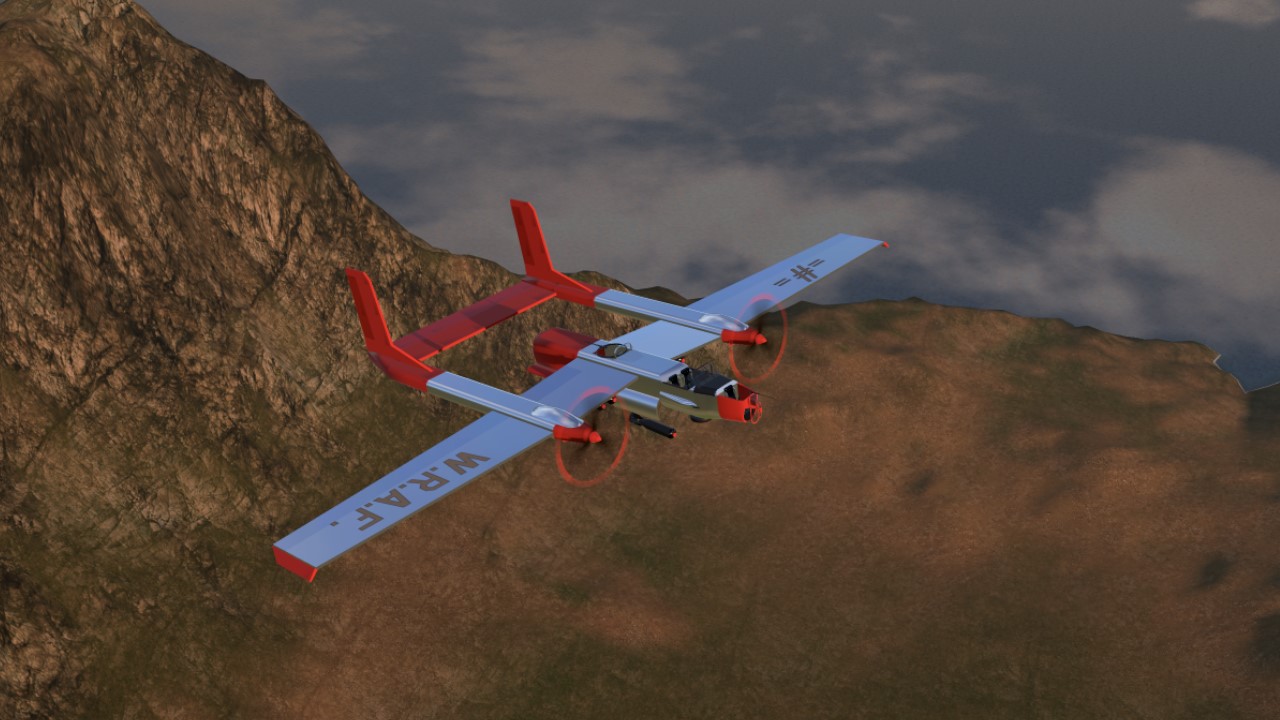An L4-YL drops bombs on a practice range in 2407 G.T. Note the testing paintjob and the open gondola doors under the rear fuselage.
VR Compatible!
Design History:
Following the end of the Three Years War, the Wright Republic Air Force found itself with a major tactical problem: It had few dedicated bombers, and none that were modern, at its disposal. Immediately after the specification was released as to what the bomber needed to do, Isles Consolidated began working on a revolutionary new prototype. While the new prototype was considered aerodynamic and fast by any given standards of the time, its open cockpit design was generally found to be unusual, and in later -E variants this would be rectified. The aircraft used two shaft-driven V8 750-horsepower engines, contained under bulbs in the twin tail, and could in theory carry up to 12,000 pounds of ordnance. (Earlier bombers, such as the BH-MTH biplane, could only carry 1,500.)
Originally, the plane was defended by two 7.7x50mm Stravson M/35 machine guns in the nose and dorsal ring, but this armament was considered very insufficient. A second M/35 was added to the dorsal ring but the lack of ventral defense was still a major concern. To rectify this, Isles Consolidated added a large fuselage extension which contained a retractable gondola armed with yet another M/35. It offered excellent views and a prime firing position for the operator, but the armor it had was generally subpar. Despite this, it proved to be effective in trials and the planning continued. Once the prototype was assembled in 2405 G.T. it underwent numerous trials by the W.R.A.F., proving satisfactory. The L4-YL-C variant added four Manklav 15x112mm B-23 machine guns in forward gun pods, rocket pylons on the wings, and several other modifications to turn it into an impromptu strike bomber.
Operational History:
After completing its trials in 2407 G.T., it was immediately ordered into production with an initial order for 450. Several later orders would follow, totaling all models to 4,350 examples. The aircraft served well throughout various conflicts until 2420 G.T., when it was pulled out of service in favor of new models. The eternal mounting points for stores greatly increased its wartime load, and while the shaft-driven engines were prone to overheating, the relatively low horsepower was still sufficient to reach up to 272 mph at 13,600ft. The defensive armament was excellent for the time, but unfortunately the gondola greatly increased drag and so reduced the maximum speed when deployed. When used in the strike role, the forward firing armament was more than enough to destroy most ground targets, and the L4-YL made quite a name for itself in the infantry support role.
Controls/Flight Performance:
- Maximum Speed: 272 mph at 12,600 feet.
- Stall: 68 mph.
- Range: 183 minutes in-game.
Armament:
4x Stravson M/35 7.7x50mm machine guns in dorsal, ventral and nose emplacements. (1200 rpm, 700 m/s.)
4x Manklav B-23 15x112mm machine guns in fixed forward position. (780 rpm, 800 m/s.)
8x 3.75in rockets (HE)
7x 250kg bombs. - VTOL down for flaps
- AG1 for bomb bay, AG2 to lower gondola.
Look input for defensive gun control.
Notes:
- The yoke is kinda like the yoke of Theseus, I copied the design but built it myself.
- The G-Meter isn’t 100% accurate, but I didn’t want to mess with it too much.
You will have to un-hide the aircraft after downloading.
This thing took me about nine months of work, thank you so much for checking it out!
Specifications
General Characteristics
- Created On Mac
- Wingspan 85.9ft (26.2m)
- Length 49.7ft (15.1m)
- Height 18.0ft (5.5m)
- Empty Weight 12,516lbs (5,677kg)
- Loaded Weight 14,684lbs (6,660kg)
Performance
- Horse Power/Weight Ratio 0.095
- Wing Loading 16.9lbs/ft2 (82.4kg/m2)
- Wing Area 869.7ft2 (80.8m2)
- Drag Points 5427
Parts
- Number of Parts 253
- Control Surfaces 9
- Performance Cost 1,413





If the P-38 and the B-24 had a child, lol
This is awesome, though!
Damb this is nice